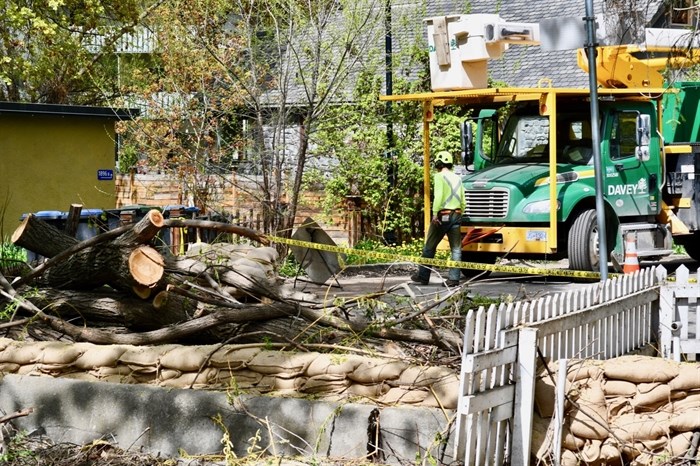
Remedial work is performed by contractors along Mill Creek in Kelowna, May, 2018.
(JOHN MCDONALD / iNFOnews.ca)
May 30, 2018 - 5:30 PM
KELOWNA - The immediate cause of last spring’s flood along Kelowna’s Mill Creek was an ill-timed rainstorm on top of a higher-than-normal spring freshet.
But years of benign neglect by the City of Kelowna and the provincial government left Mill Creek overgrown with vegetation and full of gravel, reducing the creek’s overall volume and leaving the sudden influx of water on May 4 and 5, 2017 nowhere to go but over its banks.
The city says it’s the province’s fault for previously denying them permission to dredge the creek and cut back trees and bushes along its banks.
But the province says it has never denied permission to clear the creek and says the city has never previously provided the proper environmental and engineering studies allowing them to proceed.
Before 2017, most residents didn’t pay much attention to Mill Creek, the waterway that roughly follows Highway 97 through Kelowna.
The creek keeps a low profile through much of its 35-kilometer length, winding through farmland and alongside some big industrial areas before looping its way through some downtown residential neighbourhoods and then emptying into Okanagan Lake beside the Bennett Bridge.
But last year, Mill Creek proved to be anything but low profile when a larger-than-normal spring run-off combined with a saturating rainstorm caused it to burst its banks at dozens of points.
A report from Dobson Engineering describes the creek as “adversely impacted” by years of development and notes the construction of the Mill Creek diversion in 1985 was done to help prevent flooding by channelling excess water through a pipe to Mission Creek.
However since then, nothing has been done to maintain the creek’s volume of 3.2 cubic metres per second recommended then by the Ministry of Environment.
“As a result of the obstructed flows there was severe and costly flooding within the city during the 2017 high flows,” the report notes.
Director of infrastructure Alan Newcombe could not find record of a previous application but said the city has had verbal discussions with their Ministry of Forests, Lands and Natural Resources counterparts where clearing the creek was discussed, but to no avail.
"When discussions had occurred, there was little positive progress to allow alterations or disturbances to, and within, the riparian areas,” Newcombe said in an emailed statement.
"When new infrastructure is required and impact to the riparian area is unavoidable only then will works be approved,” Newcombe added. "The approvals may also be accompanied with significant mitigation/compensation measures to be implemented as a condition of approval.”
However ministry media relations officer Jeremy Uppenborn said in an emailed statement there is no record of them having rejected an application, which would have required both an environmental assessment and a hydrology report.
Uppenborn said the ministry issued a change approval in 2015 to dredge 1.1 kilometres of Mill Creek at Kelowna International Airport as well as a change approval issued March 28, 2018 for the remedial work done this spring ahead of the freshet.
He characterized the application process as "complicated", which must take into account fish, bird and animal habitat and First Nation archaeological sites along the creek, with the actual clearing work made more difficult by private property and the need to consider the whole creek, not just certain sections.
"The hydrologic impact of the work must be understood,” Uppenborn says. "It is not enough to dredge small sections, as the stream will just redistribute the problem elsewhere. Urban stream maintenance requires an approach where the entire reach is studied.”
Uppenborn said Kelowna’s hiring last year of Dobson Engineering to complete a proper environmental management plan lead them to “quickly issue” the necessary permits.
“More recently, the city has hired a consultant who understands urban streams,” he said.
There’s no reliable estimate of the damage caused by the 2017 flood to private homes and businesses along Mill Creek.
Private insurance would have taken care of most of the damage, however the city is at least partially protected from liability.
City of Kelowna risk manager Lance Kayfish said section 744 of the community charter protects municipalities from liability arising from the breakdown or failure of a drainage utility.
The Emergency Program Act also shields against liability from emergency operations and protective actions taken during a disaster, Kayfish added.
"More importantly... however is that to attract liability there has to be negligence, which is based on reasonableness and requires looking at the whole picture,” Kayfish said. “People always have the right to make a claim, for it to be successful they have to prove negligence."
Kayfish added only one person has said they are going to sue the city over last year’s flooding, but it’s not connected to Mill Creek.
To contact a reporter for this story, email John McDonald or call 250-808-0143 or email the editor. You can also submit photos, videos or news tips to the newsroom and be entered to win a monthly prize draw.
We welcome your comments and opinions on our stories but play nice. We won't censor or delete comments unless they contain off-topic statements or links, unnecessary vulgarity, false facts, spam or obviously fake profiles. If you have any concerns about what you see in comments, email the editor in the link above.
News from © iNFOnews, 2018